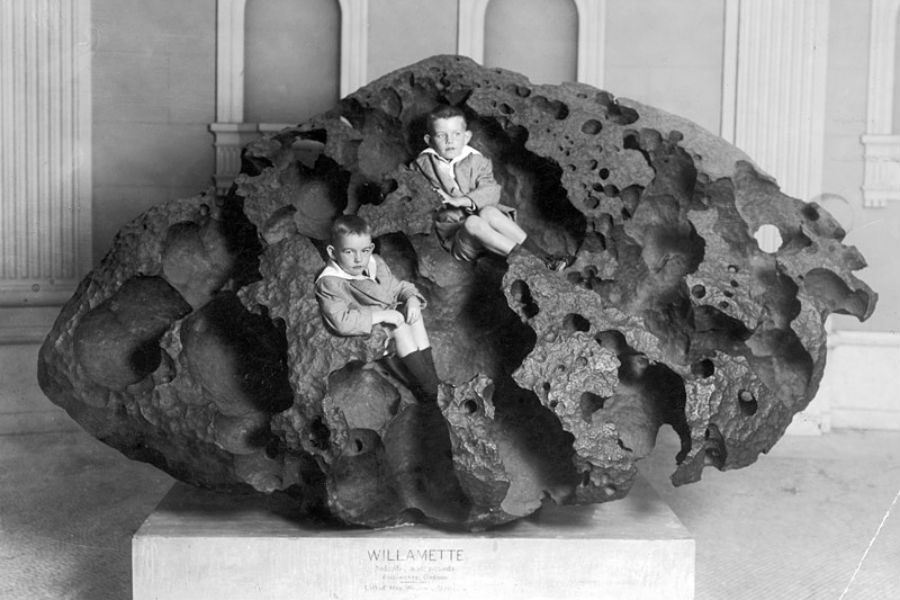Rocks from outer space had been visiting earth since the beginning of times.

Although the one and only Chicxulub Impactor (11-81 kilometres in diameter) that wiped out the dinosaurs some 66 million years ago, hold the record for the biggest ever meteorite to ever hit the earth, it is neither the first nor the last of such visits.
Some were lucky enough to survive the journey into our atmosphere and made the earth their home while some just evaporated creating spectacular shooting stars, and of course, there were others who narrowly missed the earth! Among these alien rocks, there are pretty big ones weighing as much as dozens of grownup elephants!
And these are the 5 largest, burnished and strangest looking meteorites that were lucky enough to enter the earth, obviously since the Chicxulub impactor. Enjoy!
- The Willamette Meteorite

The 6th largest meteorite found on earth. Currently, on display at the American Museum of Natural History, this massive rock weighs 15.5 tonnes (15500 Kg) and about 7.8 square metres in size. Made from metallic iron, Willamette is one of the 600 iron-based meteorites ever to be found on earth from a total of 25,000 others. its interaction with rainwater is thought to be the reason behind its big cavities. This is believed to hit the earth a few thousand years ago and was initially found in Oregon, USA. The Clackamas Indians who lived in the area calls the meteorite “Tomanowos” and believes it holds great spiritual value.
- Mbozi Meteorite

This was discovered in the 1930s in Tanzania and is one of the largest meteorites found on earth. Mbozi weighs an impressive 16 tonnes (16,000 Kg) with a 3-metre length and a 1-metre height. The locals had called it the “kimondo”. Mbozi is categorised as an ungrouped iron meteorite and it did not have a crater where it was situated. A man-made plinth supports the rock after it had been partially excavated in the 1930s. Currently, it is being protected by the Department of Antiquities since 1967.
- The Bacubirito Meteorite

This is the longest meteorite found on earth which is 4.25 metres long. It was found in 1863 in Sinaloa, Mexico and holds the record for the biggest meteorite in Mexico and the 6th largest in the world. This iron meteorite weighs between 20-22 tonnes.
- El Chaco Meteorite and the Gancedo Meteorite

They both come from a single meteor shower that fell in the Chaco province in Argentina about 4200 – 4700 years ago. El Chaco (29 tonnes) was discovered in 1969. The other larger piece of meteorite, the Gancedo (31 tonnes/ 30800Kg) was discovered very recently in 2016. Gancedo meteorite is now the third-largest in the world.
This meteor shower left 26 craters in the area and across 1350 square kilometres. This group of iron meteorites found in this area is called, “Campo del Cielo”. Its largest rock is 119 x 91 metres in size! The rocks are estimated to be 4.5 billion years old.
- The Cape York Meteorite

It is believed that this monster rock landed on earth about 10,000 years ago and is about 4.5 billion years old. As nearly as old as our sun! This massive iron meteorite was discovered from Greenland in 1894. The Inuit that lived in the area had been using this as a source of metal to forge their tools.
“Cape York” is the name given to the original meteorite where this piece of iron (called “Ahnighito”) was broken. Ahnighito and two other smaller parts of the Cape York Meteorite can be seen in display at the American Museum of Natural History. At nearly 31 tonnes (30875Kg), Ahnighito is the heaviest meteorite on display in any museum around the world. Because of its weight, the supports Ahnighito weighs on run deep down to the bedrock under the museum. It is the second-largest meteorite in the world.
- Hoba Meteorite

This is the monster rock of them all! Weighs a massive 60 tonnes and almost twice as the second-largest space rock Ahnighito. Hoba is the largest intact single-piece meteorite in the world. Even today, it stays where it was landed in Namibia 80,000 years ago. With a flat surface on both sides, Hoba is 2.7×2.7×0.9 metres in size. It has a composition of iron, nickel and cobalt. It was found in 1920 by accident while Jacobus Hermanus Brits was ploughing the field above it. Hoba does not have any crater where it landed.

